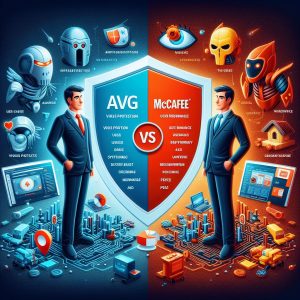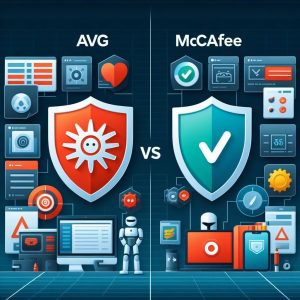I. Introduction
Antivirus software is an essential tool for protecting devices against malicious threats like viruses, ransomware, spyware, and more. Both AVG and McAfee offer antivirus suites incorporating real-time scanning, firewalls, VPNs, and additional utilities to secure personal computers as well as mobile devices.
AVG AntiVirus FREE is made for basic protection of Windows devices. McAfee Total Protection provides complete, customizable security for all devices and platforms. Both AVG and McAfee offer paid upgrades to unlock more features beyond core antivirus. There is an ongoing debate over whether AVG or McAfee offers superior malware detection and overall cyber protection weighed against performance impact.
This comprehensive guide will compare AVG versus McAfee across key metrics like included features, system performance benchmarks, pricing models, and customer satisfaction ratings. Read on for a complete breakdown of both solutions to help inform which antivirus software aligns best with your specific use case and security priorities.

II. Features and Protection
One of the main differentiators between AVG and McAfee lies in the extent of security protections included out-of-the-box. AVG AntiVirus FREE focuses specifically on fundamental antivirus capabilities while McAfee Total Protection packages in extra utilities like password managers and identity protection.
In independent testing by AV-Test Institute throughout 2022, both AVG and McAfee demonstrated stellar results defending against widespread malware. However, McAfee showcased slightly better capabilities blocking targeted zero-day threats on Windows 10 platforms. This indicates McAfee may offer more robust protection for power users that are more likely targets of sophisticated attacks.
Some core features offered across both platforms include:
● Real-time scanning and scheduled updates
● Quarantine for isolating detected threats ● Available firewall protections
● Web filtering and antivirus browser extensions ● Vulnerability scanner assessing security gaps
More advanced protections found exclusively in McAfee Total Protection products encompass:
● Password manager and encrypted online storage ● Dark web monitoring for compromised personal data
● Multi-device VPN for anonymous browsing ● Identity theft insurance with case management ● Parental controls for managing children’s access
When it comes to anti-phishing capabilities, McAfee generally earns higher marks for detecting fraudulent emails and blocking access to known scam sites. Features like suspicious link highlighting add extra phishing protection, though both platforms offer decent defenses against phishing attempts.
One advantage of AVG over McAfee lies in performance optimization tools for speeding up slow devices, reducing startup times, and freeing up disk space. These utilities help counteract some of the added system drag common with more full-featured antivirus products.
III. Compatibility and Customer Support
In terms of platform compatibility, AVG offers security applications for Windows, Mac, Android and iOS devices. This allows protection across all common consumer gadgets with a single subscription.
McAfee supports all these platforms and adds in extra utilities for Linux operating systems. It also integrates with a wider array of business endpoints for large enterprise deployments, including various network gear, servers and hypervisors. For the average home user with strictly personal devices, both AVG and McAfee present equal cross-platform versatility.
For customer support, McAfee distinguishers itself with 24/7 availability across multiple contact methods. Support options include phone, online chat, email ticketing, guided troubleshooting resources, and an online user forum community. AVG lacks round-the-clock support accessibility but does provide ticket-based email assistance during normal business hours.
Most users report favorably on the quality of customer guidance received from both McAfee and AVG. However, average response times tend to be lower with McAfee, likely owing to more availability and larger support staff.

IV. Pricing and Additional Features
As mentioned previously, AVG AntiVirus FREE furnishes fundamental, signature-based malware protection at no cost for Windows devices. This presents a very compelling option for cash-strapped consumers that still want baseline antivirus defenses.
However, the premium AVG Internet Security software unlocks crucial real-time scanning and automatic updates for persistent threat prevention in the background. Annual AVG pricing starts at $79.99 covering unlimited Windows and Mac machines.
McAfee’s pricing structure proves more complex with multiple standalone options and frequently changing promotional offers. Entry-level McAfee AntiVirus runs $59.99 per year for a single Windows device. McAfee Total Protection bundles in the most features starting at $99.99 annually for five device licenses.
In terms of bang-for-buck paid upgrades, McAfee Total Protection adds considerable extra utilities like password management, secured cloud backup, and the privacy protection resources. AVG Internet Security offers protection parity with McAfee Antivirus but cannot match the more robust productivity features found in McAfee’s packages.
V. User Experience and Performance
Installing, configuring and managing security software inevitably adds some friction into general computer usage. When it comes to the impact on user experience and system performance, McAfee tends to have more noticeable effects than AVG products.
Independent testing repeatedly shows McAfee solutions have greater degradation on baseline system benchmarks. File copying, launching applications, website loading and other common tasks take moderately longer under McAfee compared to AVG in multiple lab evaluations. This performance gap stems from McAfee’s more exhaustive threat scanning and added security layers.
However, for the actual process of installing, updating and accessing antivirus controls, McAfee generally offers a more polished interface. Though AVG’s console displays logically organized functions, McAfee feels more responsive and intuitive through menus and module dashboards. Streamlined reporting and automation settings also give McAfee an edge for business administration needs.
One recurring complaint around McAfee hardware usage manifests in high background CPU utilization even when idle. AVG claims much lower passive overheard while still running real-time monitoring processes. Thus users with older computers or multitasking workloads may find McAfee too taxing compared to AVG’s lighter touch.
VI. Expert Testing and Ratings
Evaluating precise detection rates and benchmark performance requires professional lab testing under controlled conditions with live malware samples. Both AVG and McAfee demonstrate leading effectiveness according to the latest examinations by AV-Test Institute and AV Comparatives.
However, McAfee consistently outperforms AVG in malware protection scoring for identifying the highest percentage of threats with fewest false positives. This gap appears most prominently defending against advanced targeted attacks unseen in previous signature databases.
In one 2022 test against 250 zero-day threats by AV-Comparatives, McAfee Internet Security blocked 96% compared to AVG’s 89%. Against widespread malware, both aligned closely with 100% and 99.7% protection respectively.
When weighing the all-inclusive impact on security, performance and usability, AV-Test Institute ranked McAfee Internet Security among the top antivirus products, trailing closely behind Kaspersky Internet Security. AVG Internet Security placed lower marking deficiencies in some phishing identification and simulated targeted attack scenarios.
Multiple factors contribute to McAfee outpacing AVG in expert testing evaluations:
- More advanced heuristics and behavior analysis
- Larger threat intelligence database from extensive endpoint base
- Better process isolation containment of undetonated threats
- Machine learning detection models continuously improving over time

VII. User Feedback and Common Issues
Beyond lab environments, real-world user experiences reveal added considerations around ease of use, recurring problems, and overall satisfaction with antivirus software.
For AVG, one sticking complaint from customers involves excess promotional pop-ups nudging free users to upgrade to premium products. Interstitial upgrade ads prove frustrating over time. Some reviewers also take issue with difficulty completely uninstalling AVG software without leftover processes and registry entries dragging on system resources.
McAfee garners mixed feedback when it comes to performance drag and CPU usage spikes slowing down computers noticeably. Gamers and video editors in particular report throttled frame rates and choppy playback under McAfee not manifested with other antivirus options.
On positives, long-term McAfee devotees praise highly responsive customer service getting problems swiftly resolved. AVG wins user favor with lighter system impact for uninterrupted productivity and enjoyment. Both receive positive marks for blocking the vast majority of malware threats with minimal configuration.
VIII. Conclusion
In closing, AVG AntiVirus FREE makes an outstanding baseline protector for cash-strapped consumers willing to sacrifice some real-time capability. In terms of premium products, McAfee generally outshines AVG with broader protections and utility features wrapped in a polished interface, albeit at the cost of added performance overhead.
McAfee proves better equipped to handle targeted, zero-day threats thanks to its extensive network effect of ever-expanding threat intelligence. Power users and anyone managing sensitive data should lean towards McAfee, especially with bundled password manager, online backup and identity protection.
However, for undemanding workflows like web browsing, AVG provides reliable malware blocking without the same intensity of system slowdowns. With less noticeable passive drain, AVG fits better for older machines and gaming rigs sensitive to drag. Users not seeking extras like VPNs or cloud storage can rely solely on AVG’s core antivirus protections.
In summary, AVG AntiVirus excels on simplicity and performance while McAfee Total Protection wins out with superior detection rates and bonus offerings. Weighing personal priorities around security versus productivity helps determine the right brand for your devices.